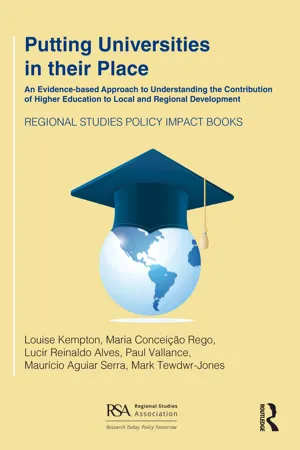
Putting Universities in their Place
An Evidence-based Approach to Understanding the Contribution of Higher Education to Local and Regional Development
- 88 pages
- English
- ePUB (mobile friendly)
- Available on iOS & Android
Putting Universities in their Place
An Evidence-based Approach to Understanding the Contribution of Higher Education to Local and Regional Development
About This Book
There have been several attempts in recent years to create conceptual frameworks and models to help universities and policy makers understand the role and contribution of higher education to local and regional development. However, these models have failed to fully reflect or give insufficient attention to the impact of the regional context (economic, social, political), the policy environment for higher education and territorial development and the diversity of management and leadership structures of universities themselves. This has led to the development of static models that rarely work outside of the immediate context in which they were developed and therefore risk leading to design of policies that are not fit for purpose.
This Policy Expo is the result of work with partners in Europe, South America, Africa, Asia and Australia to develop a new approach, the ORPHIC Framework, to think about how the university can be adapted to the specificity of institutional and local contexts. The book examines:
• What are the different roles that universities play in local and regional development and how do these manifest themselves?
• How can we learn from comparing practice and experience internationally, and to what extent are policies aimed at promoting university–region relationships transferrable?
• What are the internal university factors, such as management and leadership, history, mission, structures, and the external factors, such as territorial development policy context, governance system, nature of the 'place', that might help us explain the nature of the relationship?
Frequently asked questions
Table of contents
- Cover
- Title Page
- Copyright Page
- Contents
- Foreword
- About the Authors
- Executive summary
- Key recommendations
- 1. Introduction
- 2. Understanding the contributions of universities to regional development
- 3. Examining university models in regional development
- 4. Placing universities and regional relationships in context
- 5. Putting universities in their place: The ORPHIC Framework
- 6. Recommendations for policymakers
- Glossary
- Appendix A: Responses to the survey questionnaire
- Series Page